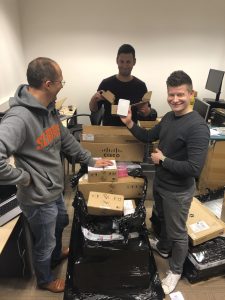As people who know me can tell you, I talk a lot about change, on both a personal level and an organizational one. Over the last five years, Cisco has changed dramatically as a company both in the products we make and how we sell them. I personally have changed how I interact with customers and employees. I listen more and talk less (hard to believe, I know), and I’ve learned a great deal as a result.
So when I get a chance to work with people who feel the same way about change as I do, I get really excited. That’s what happened recently when I had the chance to meet with Pavel Brusnicky, the principle network architect at Philips.
I’m sure most of you are familiar with the Philips brand; it’s been a major player in the consumer electronics world for decades. You might even know that the company is an industry leader in health and well-being. Philips is based in more than 100 countries worldwide. Philips strives to make the world healthier and more sustainable through innovation. Their goal is to improve the lives of 3 billion people a year by 2030. Philips operates across the healthcare continuum with products in Personal Health, Connected Care, and Diagnosis and Treatment.
What you’re probably not aware of is the massive internal network change Philips is undergoing with Cisco’s help. In 2016, Philips wanted to bring cloud concepts into the network to improve performance, network management, automation and troubleshooting. The Philips Digital transformation required a Digital network based on SD-LAN concepts. They’re ripping out the legacy hardware in their local area networks and replacing it with our intent-based networking gear. They’re implementing our Cisco DNA Center and software-defined networking products. And that’s only the beginning. These changes and many others will fundamentally alter how the company connects with its 77,000 employees and more than 300 offices, as well as its strategic partners and customers around the globe.

But all of these changes are necessary for the next step in the company’s digital transformation: A shift away from hardware to solutions, covering the healthcare continuum to improve the lives of 3 billion people.
At Cisco we know a little bit about what it’s like to shift from hardware to software. So over the next year I’ll be chronicling their transformation here, following their deployment phases and sharing best practices and lessons learned.
Aligned on principles
Philips and Cisco have other things in common as well. We’re both committed to changing the world by connecting people, places, ideas, and things. Each year Philips partners with universities and institutions to fund research into innovative healthcare solutions. Their goal is to make the world a healthier and more sustainable place for all.
Cisco also pours billions of dollars into research and the betterment of mankind. Last year alone Cisco spent more than $6.5 billion on R&D into innovative technologies, while the Cisco Foundation is a leader in corporate social responsibility.
Philips has just completed the first deployment of SD-Access, a solution that combines Cisco DNA Center, Cisco Identity Services Engine, Cisco Catalyst 9000 networking gear, and more. This will provide granular access control to applications and data on the network, based on the user and the device, which is fundamental in achieving an intent-based network. And Philips is just getting started. Over the coming months the company will begin taking advantage of machine learning and AI to dynamically improve its network.
A personal journey
Pavel also has personal reasons for sharing this journey with us. He believes Cisco is the only company that has the product depth, expertise, and services to help drive a project at this scale. (I had to agree with him — though I admit to being slightly biased.) And he wanted to help educate other organizations going through their own transformative process.
Because he understands as well as I do: If you spend all your time standing still you’ll never move forward.
 Check out some of the products Philips uses:
Check out some of the products Philips uses:
Subscribe to the Networking Blog


CONNECT WITH US